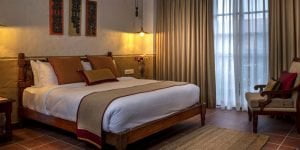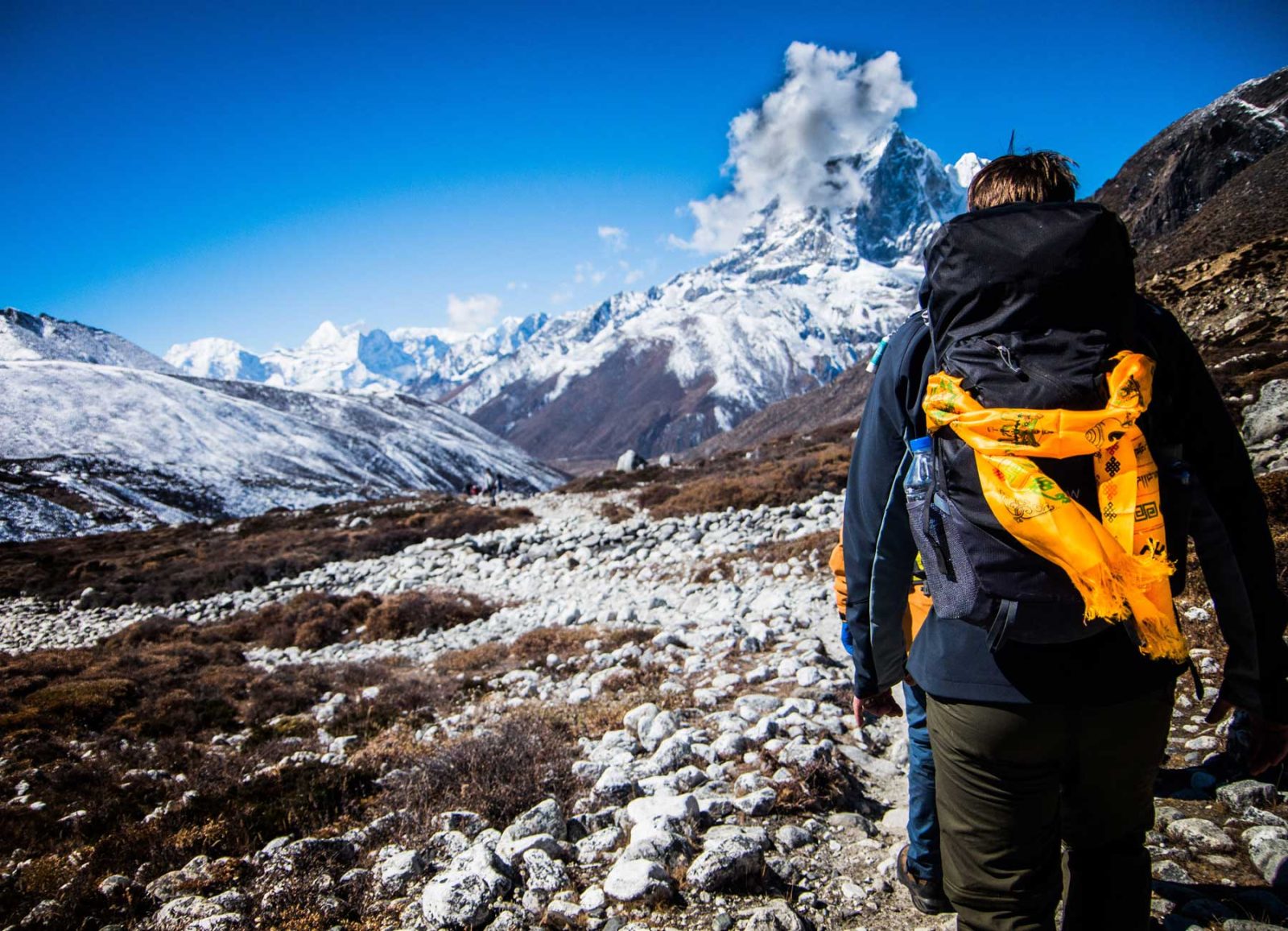Classic
Everest Base Camp
16 Days 3100 ex Kathmandu
Accommodation
3 Nights Hotel Stay
12 Nights Tea House

Transportation
Mostly on foot
Transfers and flights included
1 Porter 1 Trekker Policy

Included Meals
15 Breakfasts
14 Lunches
12 Dinners
All Open Menu Your Choice

Trip Grade
Category 3
High Heart Rate Holiday
Our Nepali guides, seasoned custodians of these high realms, counsel patience, a slow tread. “Bistari, bistari”! Here, in the thin air where breath comes dear, the body labors under the simplest of exertions. This truth reveals itself with stark clarity as we navigate the undulating moraine, a legacy of the Khumbu Glacier, on our approach to Everest Base Camp.
The time is post-meridian, the sun arcs high, and our path takes us ever closer to our expedition’s zenith. Below, the Khumbu Glacier, a frozen river in slow, inexorable motion, cascades from the Everest massif, carving its way down the valley to Dingboche, moving at the languid pace of one meter each day. Now and again, the glacier’s voice – a groan, a grind – punctuates the silence as colossal seracs, ice sentinels thirty meters tall, jostle and shove in their glacial procession.
Above, the Himalayas, a pantheon of earth’s mightiest peaks, loom. Their grandeur defies words, their scale humbles. These sentinels of rock and ice overshadow all other mountain brethren by leagues. To grasp their magnitude, consider this: Everest Base Camp itself, a mere starting point in the shadow of Everest, perches over 1200 meters higher than Western Europe’s loftiest peak, Mont Blanc. And yet, from this camp, Everest’s summit soars another 3300 meters skyward.
Amidst this grandeur, one is torn – where to rest one’s gaze? The summit of Everest, the bustling base camp, a monolithic serac, a distant avalanche; all vie for attention. It is at this moment, amidst these myriad wonders, that an epiphany dawns – you have arrived. You stand at Everest Base Camp, threshold to the ‘third pole’, the genesis of countless legendary ventures. Here, the goal that spurred relentless training and preparation merges seamlessly into the rich mosaic of experiences that have marked your ascent to this point.
As we advance, the trail brings its own enchantments. Yaks amble past stupa clusters, their prayer flags fluttering like vibrant whispers against the sky. The storied peaks of Ama Dablam, Lhotse, and Pumori stand sentinel. Our ascent to Everest Base Camp is a meditation in motion – past yeti legends, spinning prayer wheels, and chanting monks; past the scent of incense and the welcoming warmth of tea houses. Each step is accompanied by a hot plate of dal bhat, each moment woven into the vibrant tapestry of our EBC Base Camp odyssey.
In 1923, George Mallory, the dashing alpinist and writer, was asked by a New York Times reporter why he wanted to climb Everest. He famously replied, “Because it’s there.” The rest of his response is less commonly cited, but more instructive.
“Everest is the highest mountain in the world. its existence is a challenge. The answer is instinctive, a part, I suppose, of man’s desire to conquer the universe.”
Known as “Valley inside the Clouds”, Khumjung is a three-hour walk from Namche. This village is home to a yak farm, the monastery with the famous yeti scalp, and Sir Edmund Hillary’s school.
On paper, hiking to Everest Base Camp seems pretty straightforward. The actual distance covered and altitude gained is certainly not that much. And that’s the point. At these high altitudes (meaning 3500 meters and above), we have to take it slow. The body needs time to acclimatise and as such, we need to keep the distance and more importantly, the altitude gained to a minimum.
On our trip, we have included 2 acclimatisation days, 1 in Namche Bazaar and the other in Dingboche. These are vital days to allow your body to produce the required red blood cells to transport the diminished oxygen around your body. They are also a great opportunity to slow down, have a break, do a short acclimatisation hike, grab a coffee and cake and maybe pop into a local monastery.
So a typical day’s hike goes something like this. Breakfast is normally around 8 am and we start hiking at around 9 am. The trail itself has a gentle incline most of the way, so we take our time meandering the trail, taking in the sublime views of the valley and the towering giants and their accompanying glaciers. Lunch is at around 12 noon in a local tea house. After lunch, we may trek for another 2 hours before getting into a village and settling in for the afternoon. That’s it.
Of course, we could do the Everest Base Camp trek faster. But if you have come all this way to stand at the base of the highest peak on the planet, why jeopardise that experience for the sake of 48 hours. Besides, you will be walking one of the most beautiful trails on the planet, why rush it? Take it in and feel blessed you are where you are, on your way to Everest Base Camp.
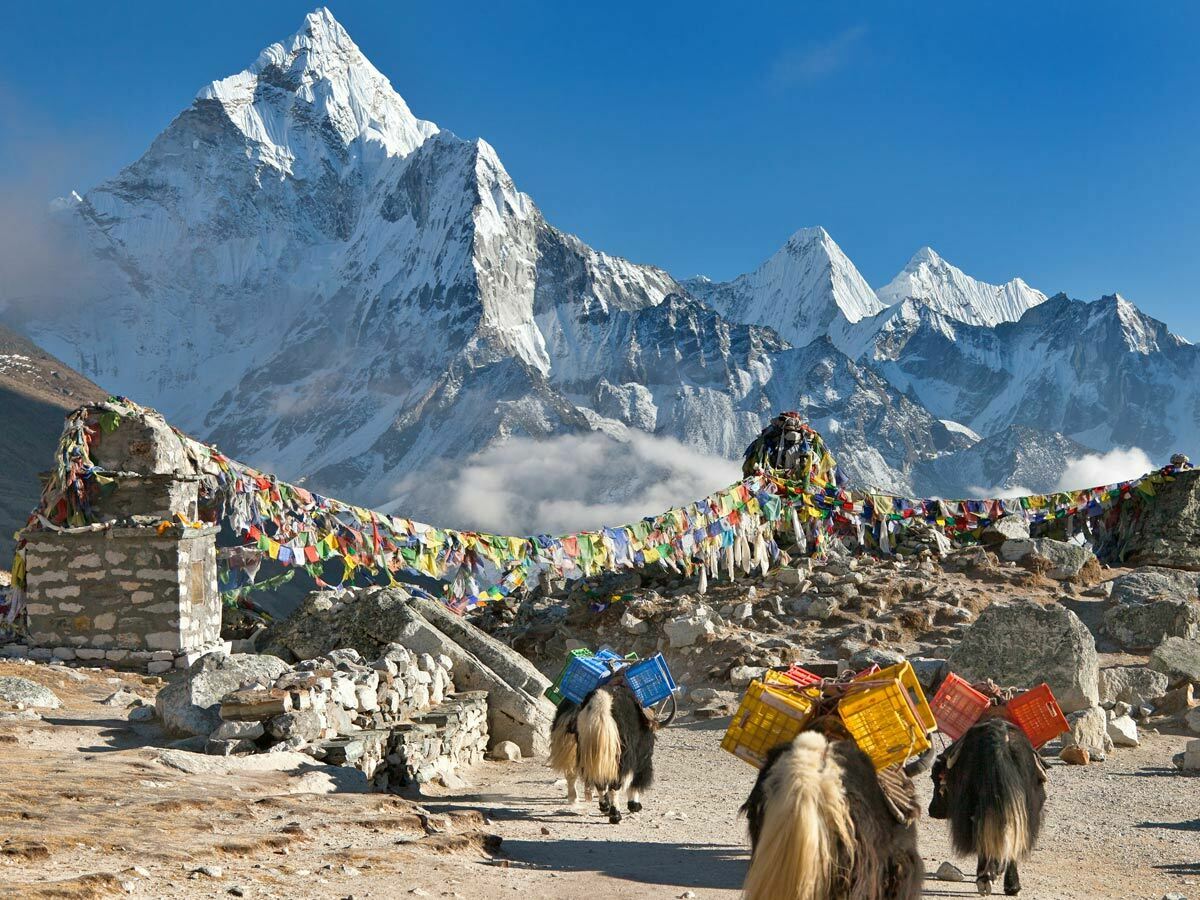
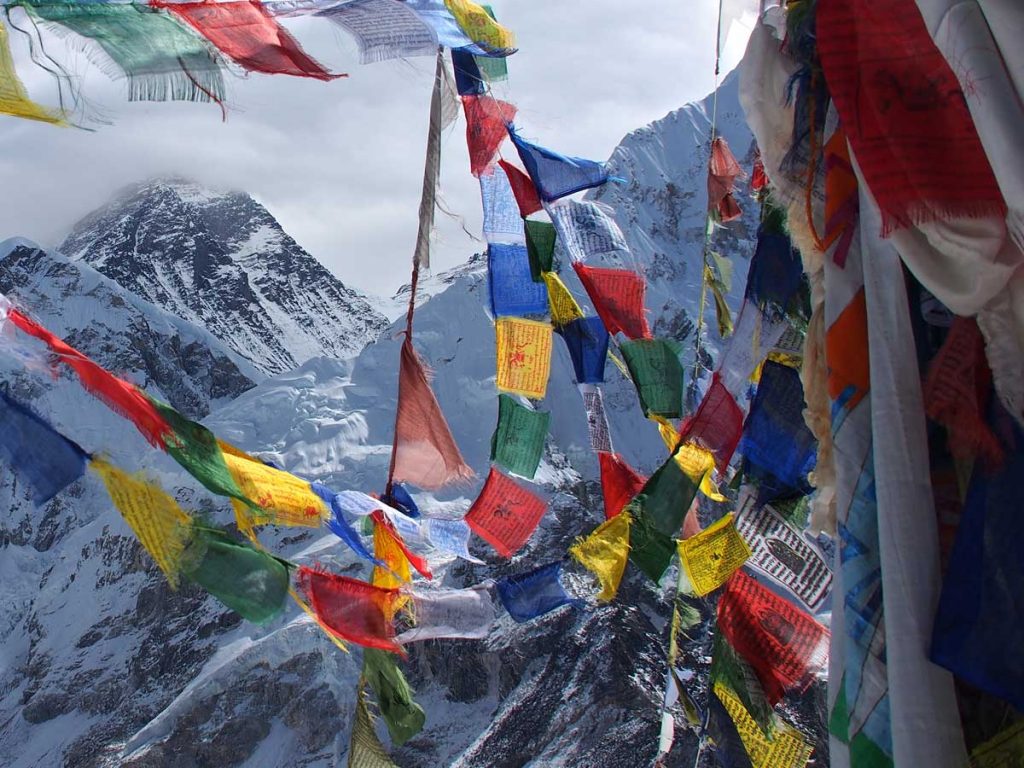
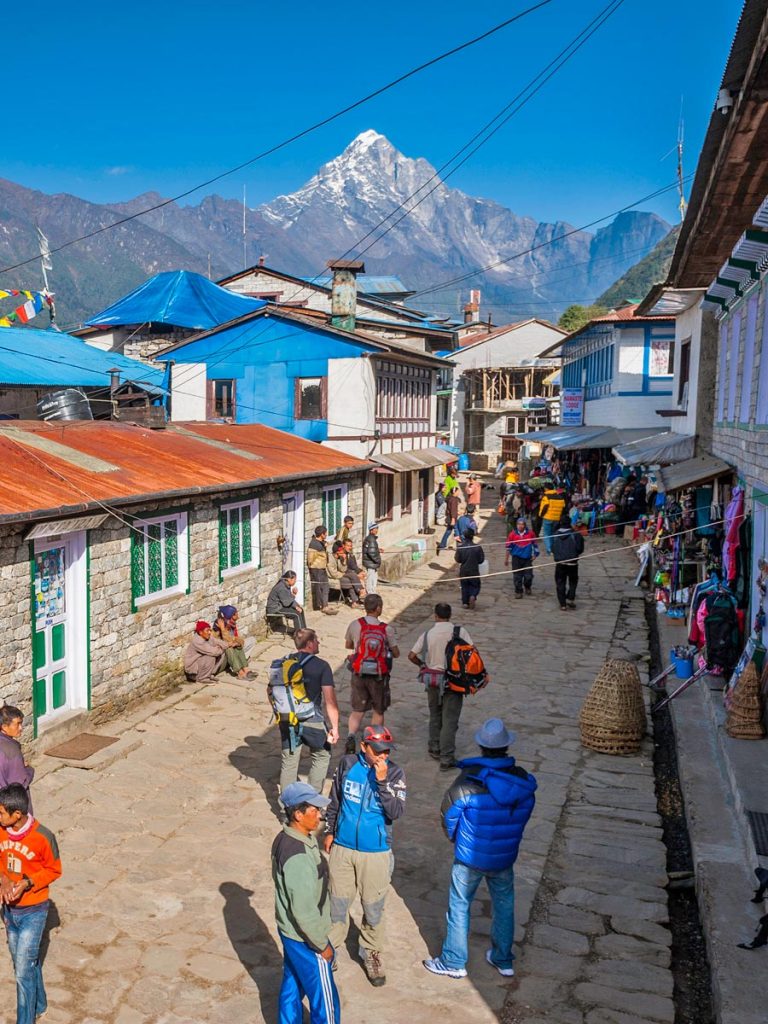
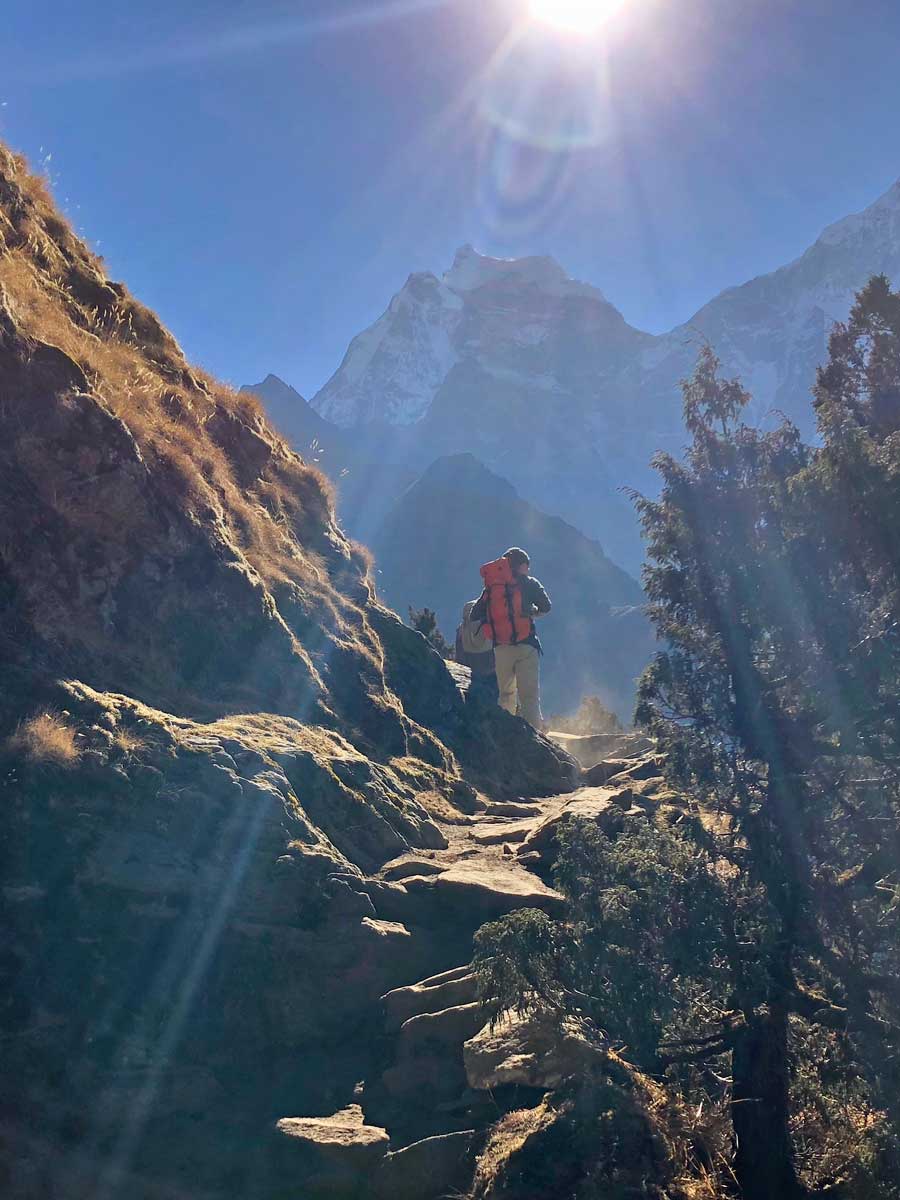
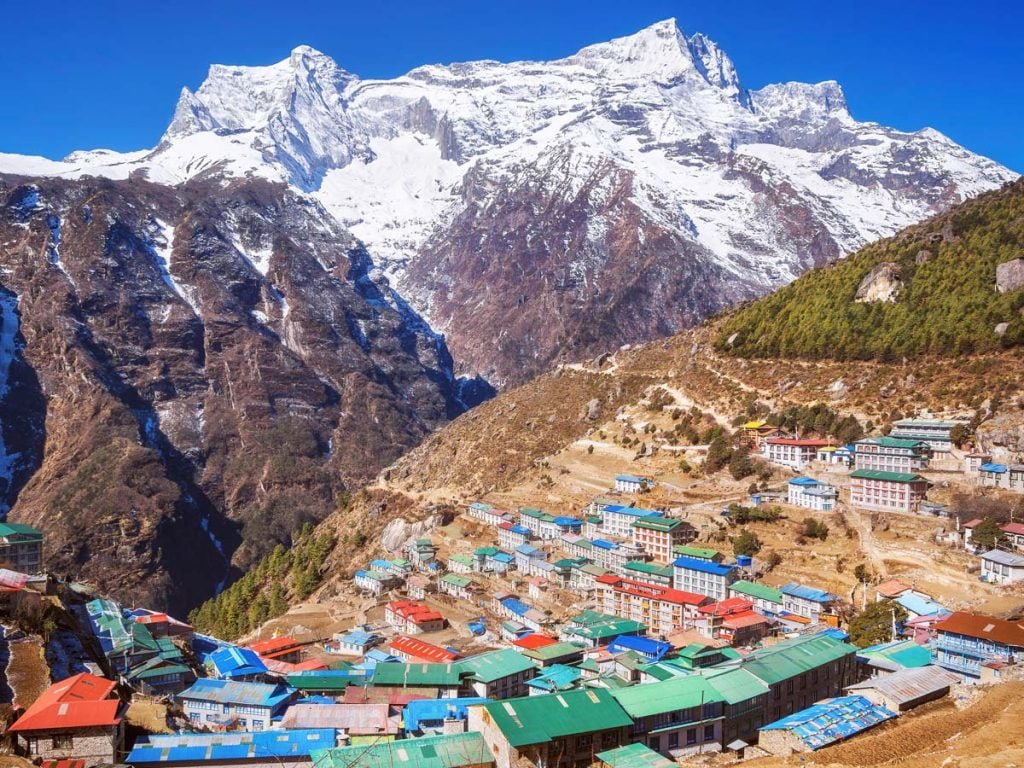
The Journey
Your group leader will meet you at the airport and take you to your hotel where you can relax, meet your teammates and take a stroll through Kathmandu’s bustling streets. We’ll enjoy a traditional Nepali dinner together and watch a cultural performance before getting much needed rest. (D)
Visit some of Kathmandu’s most noteworthy sights, including the white dome of Boudhanath and UNESCO’s Pasupatinath. You will learn about Nepal’s religious diversity while seeing ancient religious practices firsthand. At night, we’ll discuss the itinerary for our trek and what to expect in the days leading to Everest Base Camp.
The short, steep Lukla airport is one for the books. After landing, we’ll make our way through farming communities and Sherpa villages before seeing our first views of the Dudh Koshi River. Since today’s walk will be an easy one, you can comfortably take in the landscape and valley views. Over dinner at our Phakding teahouse, your guide will prepare you for tomorrow’s journey.
Namche is what postcards are made of! To get there, we’ll cross suspension bridges passing over rushing rivers and framing snow-capped peaks. Your trekking team will be sure to wake you with ample time to enjoy the day. We’ll pass several mountain villages before we enjoy a hot lunch in Jorsale. Our bellies will be full as we continue to adjust to the altitude of Sagarmatha National Park to witness our first views of Mount Everest.
Wake early to see golden mountain peaks and sip tea before we stroll to a local Tibetan-Buddhist center. Today our focus is rest and acclimatizing in preparation for climbing at higher altitude. We may even do a hike up to one of the nearby ridges, which will afford us amazing views of the mountains and improve our acclimatisation.
In the morning we will first head to the “Valley inside the Clouds”, Khumjung. This village is home to a yak farm, the monastery with the famous yeti scalp, and Sir Edmund Hillary’s school. From here, our itinerary diverges from most. We’ll skip the overcrowded traditional trails to explore the lower section of the Gokyo valley. It will take us about six hours to walk the ridge of Mong-La, and we may encounter musk deer along our way. The terraced village of Phortse will reward our efforts and keep us warm for the night.
Words can’t do justice to today’s trek. Be sure your camera is ready! Mountains will surround us and, if we’re lucky, a musk deer will cross our path to Pangbuche and Somare. We’ll have lunch in the shadows of Amadablam, and peaks that were previously hidden will slowly reveal themselves as we trek further into the Himalayas.
After breakfast, our group will go for a morning excursion to help us acclimatize further and take in the stunning 360-degree mountain views. Our destination is a hilltop where we will see a bird’s eye view of Imja valley and the village of Dingboche below. The world’s fifth highest mountain, Makalu, will also frame our photos.
Gradually we will make the ascent above the tree line and reach a wide meadow. Cholatse, Lobuche and Pumari mountains contrast this new landscape. “Sherpa’s Graveyard,” the area in which memorials have been built to honor those lives lost in this region is a sobering moment. We will rest at this landmark before continuing onto Louche, a settlement built at the foot of Lobuche Mountain.
It will take us three hours to reach Gorak Shep from Lobuche. It’s a rocky, snowy terrain, and we’ll stop for lunch before setting out for Everest Base Camp. At Base Camp, we see the icy-blue Khumbu Ice Fall and prayer flags and tents from current and past excursions. This is a moment you’ll remember for life.
Though the sunrise trek to Kalapathar is a difficult one, the sunrise view is worth it. This is the highest we will reach on our trek together. At the top, dreamy Himalayan peaks will turn purple and gold in the morning sun. We’ll celebrate before beginning our descent to Pheriche.
Taking a different route, we’ll visit the Tyangbuche Monastery. You’re welcome to light a butter lamp and visit the monastery grounds. Upon returning to Namche, you may crave a piece of apple pie at one of the local bakeries or take advantage of cheaper wi-fi prices to reconnect with friends at home.
We retrace our steps through the rhododendron forests to the banks of the Dudh Koshi. Phakding will be a friendly memory as we complete our journey. Tonight we complete our adventure together eating, drinking, and dancing at a local tea house.
In case of bad weather, we’ve scheduled an extra day in our itinerary as flights can be postponed. After reaching Kathmandu, you have earned your rest! Take a hot shower and spend the day as you please. Our leaders have recommendations for you based on your interests: gift shopping, local restaurants or late-night happenings.
Say goodbye or “Pheri Betaula” to new friends and get ready to edit many photos on your departure flight. Your leader will be there to wish you well on your journey home.
Includes
- Arrival and Departure transfers on both domestic and international flights.
- 3 nights accommodation at Harati Manor Hotel twin share
- OPEN and CHOICE of Full board meals while on expedition.
- One Trekker: One Porter Policy
- Accommodation at clean and comfortable tea houses or lodges.
- Welcome dinner with the cultural program as listed in the itinerary.
- Half day guided city tour with world heritage entrance permit as listed in the itinerary.
- All Domestic flights and airport tax.
- Private transportation to and from the starting and ending points of the trek as applicable.
- Free use of quality trekking gear – sleeping bag, fleece liner, down jacket, rain poncho.
- Professional local trek leader with Wilderness First Aid.
- Portable Altitude Chamber (PAC) / Gamow Bag (A life-saving device in case of Acute Mountain Sickness) along with a comprehensive First Aid Kit.
- Assistant trekking guides and other support staff for Everest base camp trek.
- Trekking map.
- Personal Sherpa Porters to carry all personal gear.
- Insurance of all staff including Porters.
- Warm clothing and required trekking gear for Porters like Gortex jacket /trousers, trekking shoes, woolen hat, woolen gloves, woolen shocks, sunglasses etc.
- Complimentary souvenir Tshirt.
- TIMS Trekking permit
Excludes
- International flights
- Insurance
- Tips and beverages
Journey Extensions
Check out our Journey Extensions for those that want to stay a little longer or try something different along the way.
In the heart of Thamel, is the Nepali Ghar Hotel. The Nepali Ghar punctuates the new trend of modern hotels and breezes an ode to Nepalese traditional styles. These traditions afford a warm and homely environment for all adventurers. The hotels Delux rooms are luxurious and open with excellent facilities. The hotel has a restaurant that serves great food as well as a fitness centre.
If you would like to stay at the Nepali Ghar Hotel as part of your package of 2 nights before and 1 night after an expedition the extra price will be $600 (for all 3 nights).
For twin rooms where you share the room, the price is $350 per person twin share.
In the heart of Thamel, is the Nepali Ghar Hotel. The Nepali Ghar punctuates the new trend of modern hotels and breezes an ode to Nepalese traditional styles. These traditions afford a warm and homely environment for all adventurers. The hotel’s Delux rooms are luxurious and open with excellent facilities. The hotel has a restaurant that serves great food as well as a fitness centre.
If you would like to stay at the Nepali Ghar Hotel as part of your package of 2 nights before and 1 night after an expedition the extra price will be $350 per person twin share (for all 3 nights).
For single rooms for these nights the extra price is $600.
If you would like to have your own room in Kathmandu we can organise this. The Single Supplement for all Everest Trips is $300 per person. Single rooms are not available outside of Kathmandu.
“Hi No Roads, just a quick thank you for the amazing experience I’ve just had in Nepal on the Everest Base Camp trek. Everything was spot on, from the quality of the Kathmandu hotel, the trekking equipment provided to the top quality meals along the way in the tea houses. But most importantly, I was very impressed with the expertise of the local guides (when you have a Sherpa who has successfully climbed Mt Everest twice, you know you’re in good hands), their care of the group and advice about high altitude, what to expect and little hints on how best to acclimatise assisted in getting our whole group to EBC in one piece.”
Hadyn, Australia
Trek responsibly with trained porters and guides
Our team are committed to making sure your journey is a safe and memorable one. Each guest is paired with one porter (we have a 1 Porter 1 Trekker policy) to ensure a comfortable trek, and all of our guides receive medical and mountaineering training to make sure your experience is pleasant. We provide safety equipment and bring necessary medical supplies on each trip.
Enjoy local and cultural experiences with our knowledgeable team
With side excursions to monasteries and farming villages, we take our guests on trails less travelled by other climbing companies. Along the way, our footsteps will cross the shadows of Ama Dablam as our bodies adjust to higher elevations and more rugged terrain. Returning home, we’ll travel down a different route that allows us to encounter ancient Tibetan rituals at the Buddhist Thyanboche monastery.
Prepare for an adventure of a lifetime
Before we begin our trek, our team will review our itinerary to Lukla and answer your questions about what to expect in the days leading to Everest Base Camp. The Dudh Koshi River has carved a natural trail for us to follow as we hike towards the picture-perfect village of Namche Bazaar. We’ll spend several nights adjusting to the altitude before making our way into the hidden valleys of Khunde and Khumjung. We’ll stop in Gorak Shep to prepare for our final ascent to see the ice-blue Khumbu glacier. Your stamina will be tested as we wake before sunrise to climb Kalapathar, a peak resting at 5545 meters above sea level. Here, the first rays of the morning will paint mountaintops copper and gold, and we’ll bask in the breathtaking beauty of the Himalayas. This is truly a moment you’ll never forget.
We get asked a lot of questions about the Everest Base Camp trek. The following are certainly the most common however if you have another question please let us know or the answer may be found in our Trip Notes section.
How hard is the Everest Base Camp trek?
Although climbing to the summit of Everest is legendary, you will be surprised that hiking to Base Camp is not that difficult after all. The enemy on this trek is altitude. As such we need to take it slowly so our bodies acclimatise. There are no really difficult sections on the trail with the possible exception just before Namche Bazaar and heading into Phortse. We have 2 acclimatisation days on this trek where we spend the day hiking to a higher altitude, before heading back down for our bodies to recover. If you are a reasonably active person who puts in a bit more training for this trek, you should have no problems.
Do I have to carry my own gear?
You do not have to carry you own gear all the way to Everest Base Camp. Our 1 Porter 1 Trekker policy allows us to carry all your gear for you during the day. Your bag will be at the tea house ready for you to freshen up at the end of the day. All you need to carry is a day pack which will have some wet weather gear in it such as the supplied poncho, possibly warmer clothes, water and sunscreen and some money. Usually the pack will weigh around 5kgs.
What are the Tea Houses like on the Everest Base Camp trek?
Your accommodation along the way will be the iconic Nepali Tea Houses. These Tea Houses are one of the highlights of the trip. We have handpicked what we think are the best Tea Houses along the trail to Everest. Warm and inviting, each Tea House consists of a communal hall with tables and chairs scattered around the perimeter and central to the room is the heater, which as the sun falls below the horizon becomes a focal point.
The Tea House serves up delicious food from Western staples such as fried potatoes to Nepali dal bhat. We have an open menu policy, so you can pick anything from the menu.
Bedrooms fan out from the main communal room either at the same level or upstairs. Bedrooms are usually basic and bathrooms are shared.
Each Tea House has its own history and are incredible places to stay, to fill our bellies, warm our hands and to meet other hikers from all over the world. Put simply, we love Tea Houses.
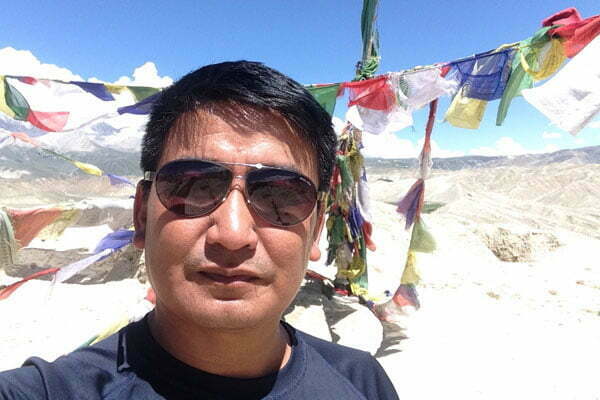
This trip is for those who have always wanted to follow in the footsteps of the great adventurers and who want to walk among the highest mountains on the planet. It is for those that are open to new cultures, who want to meet people from all over the world and who are willing to push themselves to reach Everest Base Camp. This trip is for those who have the fire of adventure still burning inside their bellies.
Pradip
Nepal Ops Manager


